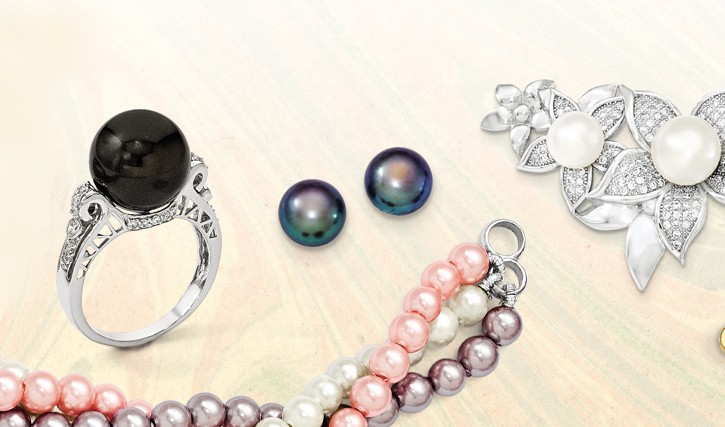Natural and cultured, fresh water and salt water, pearls are perhaps one of the best loved gems of all time. They are a world unto themselves and have their own unique vocabulary. In fact, it’s quite an extensive one, so in honor of June’s birthstone, we’ve put together this glossary to make brushing up fast and easy.
A
Akoya – Japan and China both produce saltwater cultured Akoya pearls. They are typically round or semi-round and average 6 to 8 millimeters. Akoya pearls are widely available and consumers hold them in high regard.
B
Baroque – asymmetrical, irregularly shaped pearls that are larger than keshi, rice, or seed pearls are called baroque. The name refers to the 17th and 18th style of European art characterized by ornate detail. Their free-form, organic look is best showcased in long or multi-strand necklaces.
Biwa Pearls – may be used to describe a pearl that comes from any freshwater mussel in Japan.
Body-color – the basic hue of a pearl underlying its overtone color. Naturally colored pearls can be found in most colors of the rainbow, but popular are white, grey, black, pink and coffee.
C
Cultured, or Cultivated pearl – any pearl (fresh or saltwater) grown by a mollusk containing a surgically implanted hard bead nucleus or soft tissue nucleus. In other words, these are not artificial or manmade—they are real pearls made with a little human intervention.
D
Drop – a classic tear shape that lends itself well to earrings and pendants.,
F
Freshwater pearl – pearls that form in river or lake mollusks, the vast majority are cultured but people still occasionally harvest natural ones.
G
Grading – considers seven factors for evaluating pearls—luster, surface, shape, color, nacre, size, and shape.
I
Iridescence – play of color over the surface of a pearl as interference divides white light into its component colors.
J
June – the month designated for pearl as its traditional birthstone, along with contemporary gems moonstone and alexandrite.
K
Keshi – the Japanese word for poppy seed, used to describe small natural or cultured pearls, sometimes called seed pearl.
L
Luster – the combination of surface shine (reflectivity) and inner light refraction (depth). Luster is perhaps the most important of all quality factors and is expressed in terms of high, medium, and low luster. The luster of a high quality pearl should be bright and capable of sharply reflecting objects near its surface.
M
Mabé pearls – are assembled blister pearls which grow on the inside of the mollusk shell rather than in the mantle of the organism. Once cut away from the shell, they are affixed with a mother of pearl backing. These half-domed pearls are frequently bezel-set for earrings.
Mother of Pearl – iridescent layer (principally calcium carbonate and conchiolin) lining the inner shell of some mollusk species and used for jewelry, watch faces and flatware. When it coats a bead to form a cultured pearl or composes a natural, tissue-cultured or keshi pearl, it’s called nacre.
N
Nacre – a calcium carbonate-based crystalline substance secreted by mollusks to form mother-of-pearl, pearls, and cultured pearls. Nacre secretion by a mollusk is usually a defense mechanism triggered by the intrusion of a foreign object into the body of an oyster.
Nucleation – the process of nucleating a mollusk to produce a pearl. Also called grafting or implantation, nucleation requires the insertion of either a hard bead nucleus or soft mantle tissue between the body of a mollusk and its shell or into the mantle tissue of a mollusk. The hard bead nucleus or soft mantle tissue serves as a “seed” or “irritant” to produce a cultured pearl.
R
Rice – elongated pearls, resembling puffed rice.
S
South sea pearls – Australia, Indonesia, and the Philippines are leading sources of these saltwater cultured pearls. They are typically 8 to 20 mm, high quality, and have white or pale body color.
T
Tahitian – cultured pearls produced by the black-lip oyster found in the atolls and lagoons of French Polynesia. Tahitian cultured pearls are natural in color and are produced in hues of silver, gray, green, orange, gold, blue, purple, and black. They average 9.5 mm and are held in high regard by consumers.
V
Virgin pearl – an undrilled pearl that may be prong set or glued into a mounting.
W
Weddings – pearls are the favored gems of brides worldwide.
Wipe gently- the only safe way to clean pearls. Use warm water, a mild liquid detergent and a soft cloth.
X
X-ray testing – the only reliable (non-destructive) way to determine whether a pearl is natural, cultured, or imitation.

